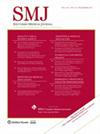足球运动员偏心腘绳肌力量失衡。
IF 1
4区 医学
Q3 MEDICINE, GENERAL & INTERNAL
引用次数: 0
摘要
目的腘绳肌拉伤(HSI)在足球运动员中很常见。偏心力量失衡被认为是导致 HSI 的一个因素。然而,关于足球和美式橄榄球运动员随着年龄增长和技术水平提高而出现的腿筋不平衡的数据却很少。与大学和职业运动员相比,高中运动员会表现出更大的肢间差异。方法使用 NordBord 腿筋测试系统(澳大利亚阿尔比恩 Vald Performance 公司)对足球和美式橄榄球运动员进行腿筋测试。记录了年龄、性别、体重、运动专长和运动水平。测量了腘绳肌的最大力量(牛顿)、扭矩(牛顿-米)和功(牛顿-秒)。腘绳肌不平衡(%)的计算方法是用腿部力量差异的绝对值除以它们的总和。结果共有 631 名运动员完成了测量,其中包括 88 名高中男子足球运动员、25 名大学男子足球运动员、23 名职业男子足球运动员、83 名高中女子足球运动员、28 名大学女子足球运动员、288 名高中足球运动员和 96 名大学足球运动员。与足球运动员相比,高中足球运动员在扭矩(P = 0.03)和功(P < 0.01)方面表现出明显的不平衡。与大学和职业运动员相比,高中男子足球运动员在最大力(P = 0.035)、扭矩(P = 0.018)和功(P = 0.033)方面的不平衡性明显更高。与大学女足球运动员相比,高中女足球运动员在扭矩(P = 0.045)和功(P = 0.001)方面的不平衡程度明显更高。结论高中足球运动员比足球运动员表现出更大的腿筋不平衡。无论男女运动员,足球运动水平越高,腘绳肌不对称程度越低。本文章由计算机程序翻译,如有差异,请以英文原文为准。
Eccentric Hamstring Strength Imbalance among Football and Soccer Athletes.
OBJECTIVES
Hamstring strain injuries (HSI) are common among football and soccer athletes. Eccentric strength imbalance is considered a contributing factor for HSI. There is, however, a paucity of data on hamstring imbalances of soccer and American football athletes as they age and advance in skill level. High school athletes will display greater interlimb discrepancies compared with collegiate and professional athletes. In addition, soccer athletes will exhibit greater hamstring asymmetry than American football athletes.
METHODS
Hamstring testing was performed on soccer and American football athletes using the NordBord Hamstring Testing System (Vald Performance, Albion, Australia). Age, sex, weight, sport specialization, and sport level were recorded. Maximum hamstring forces (N), torque (N · m), and work (N · s) were measured. Hamstring imbalance (%) was calculated by dividing the absolute value of the difference in leg forces divided by their sum. One-way analysis of variance and independent sample t tests compared measurements between athlete groups.
RESULTS
A total of 631 athletes completed measurements, including 88 high school male soccer, 25 college male soccer, 23 professional male soccer, 83 high school female soccer, 28 college female soccer, 288 high school football, and 96 college football athletes. High school soccer players displayed significantly greater imbalances for torque (P = 0.03) and work (P < 0.01) than football athletes. Imbalances for maximum force (P = 0.035), torque (P = 0.018), and work (P = 0.033) were significantly higher for male soccer athletes in high school compared with college- and professional-level athletes. Female high school soccer players had significantly higher imbalance in torque (P = 0.045) and work (P = 0.001) compared with female collegiate soccer players. Football athletes did not experience significant changes in force imbalances between skill levels.
CONCLUSIONS
High school soccer athletes exhibit greater hamstring imbalances than football athletes. Higher levels of play in soccer, for both male and female athletes, correlate with less hamstring asymmetry.
求助全文
通过发布文献求助,成功后即可免费获取论文全文。
去求助
来源期刊

Southern Medical Journal
医学-医学:内科
CiteScore
1.40
自引率
9.10%
发文量
222
审稿时长
4-8 weeks
期刊介绍:
As the official journal of the Birmingham, Alabama-based Southern Medical Association (SMA), the Southern Medical Journal (SMJ) has for more than 100 years provided the latest clinical information in areas that affect patients'' daily lives. Now delivered to individuals exclusively online, the SMJ has a multidisciplinary focus that covers a broad range of topics relevant to physicians and other healthcare specialists in all relevant aspects of the profession, including medicine and medical specialties, surgery and surgery specialties; child and maternal health; mental health; emergency and disaster medicine; public health and environmental medicine; bioethics and medical education; and quality health care, patient safety, and best practices. Each month, articles span the spectrum of medical topics, providing timely, up-to-the-minute information for both primary care physicians and specialists. Contributors include leaders in the healthcare field from across the country and around the world. The SMJ enables physicians to provide the best possible care to patients in this age of rapidly changing modern medicine.
 求助内容:
求助内容: 应助结果提醒方式:
应助结果提醒方式:


